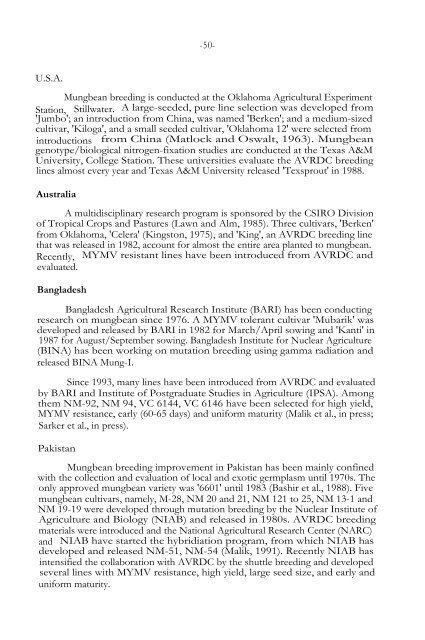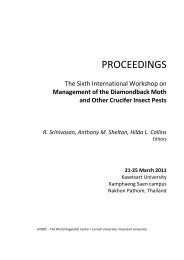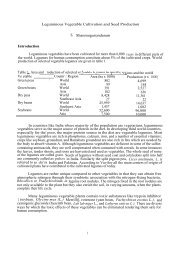MUNGBEAN VARIETAL IMPROVEMENT S. Shanmugasundaram
MUNGBEAN VARIETAL IMPROVEMENT S. Shanmugasundaram
MUNGBEAN VARIETAL IMPROVEMENT S. Shanmugasundaram
Create successful ePaper yourself
Turn your PDF publications into a flip-book with our unique Google optimized e-Paper software.
-50-<br />
U.S.A.<br />
Mungbean breeding is conducted at the Oklahoma Agricultural Experiment<br />
Station, Stillwater. A large-seeded, pure line selection was developed from<br />
'Jumbo'; an introduction from China, was named 'Berken'; and a medium-sized<br />
cultivar, 'Kiloga', and a small seeded cultivar, 'Oklahoma 12' were selected from<br />
introductions from China (Matlock and Oswalt, 1963). Mungbean<br />
genotype/biological nitrogen-fixation studies are conducted at the Texas A&M<br />
University, College Station. These universities evaluate the AVRDC breeding<br />
lines almost every year and Texas A&M University released 'Texsprout' in 1988.<br />
Australia<br />
A multidisciplinary research program is sponsored by the CSIRO Division<br />
of Tropical Crops and Pastures (Lawn and Alm, 1985). Three cultivars, 'Berken'<br />
from Oklahoma, 'Celera' (Kingston, 1975), and 'King', an AVRDC breeding line<br />
that was released in 1982, account for almost the entire area planted to mungbean.<br />
Recently, MYMV resistant lines have been introduced from AVRDC and<br />
evaluated.<br />
Bangladesh<br />
Bangladesh Agricultural Research Institute (BARI) has been conducting<br />
research on mungbean since 1976. A MYMV tolerant cultivar 'Mubarik' was<br />
developed and released by BARI in 1982 for March/April sowing and 'Kanti' in<br />
1987 for August/September sowing. Bangladesh Institute for Nuclear Agriculture<br />
(BINA) has been working on mutation breeding using gamma radiation and<br />
released BINA Mung-I.<br />
Since 1993, many lines have been introduced from AVRDC and evaluated<br />
by BARI and Institute of Postgraduate Studies in Agriculture (IPSA). Among<br />
them NM-92, NM 94, VC 6144, VC 6146 have been selected for high yield,<br />
MYMV resistance, early (60-65 days) and uniform maturity (Malik et al., in press;<br />
Sarker et al., in press).<br />
Pakistan<br />
Mungbean breeding improvement in Pakistan has been mainly confined<br />
with the collection and evaluation of local and exotic germplasm until 1970s. The<br />
only approved mungbean variety was '6601' until 1983 (Bashir et al., 1988). Five<br />
mungbean cultivars, namely, M-28, NM 20 and 21, NM 121 to 25, NM 13-1 and<br />
NM 19-19 were developed through mutation breeding by the Nuclear Institute of<br />
Agriculture and Biology (NIAB) and released in 1980s. AVRDC breeding<br />
materials were introduced and the National Agricultural Research Center (NARC)<br />
and NIAB have started the hybridiation program, from which NIAB has<br />
developed and released NM-51, NM-54 (Malik, 1991). Recently NIAB has<br />
intensified the collaboration with AVRDC by the shuttle breeding and developed<br />
several lines with MYMV resistance, high yield, large seed size, and early and<br />
uniform maturity.

















